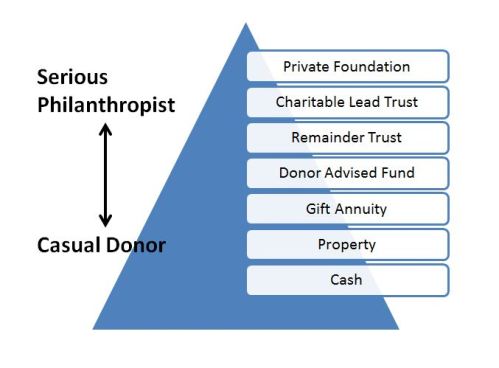Building a Culture of Philanthropy
I am a proud alumnus of Binghamton University, one of four major university centers in the 64 campus State University of New York (SUNY) system. Binghamton is a young school, founded in 1946 as Triple Cities College, an extension of Syracuse University. It became part of the SUNY system in 1950 and grew dramatically during the Rockefeller years, attaining its current status as a doctoral granting university center in 1965. The 1970’s were tough for the University as New York State faced hard economic times and funding suffered accordingly. Interestingly, the University never wavered – it continued to burnish its reputation as a very selective, high quality, world-class center of learning. Over time, the financial hard times eased, but the evolution of Binghamton from a “state school” to a “state supported school” continued. (What’s the difference, you may ask, between a “state” and a “state supported” school? Essentially, “state supported” means less and less money each year from State sources.) Regardless, Binghamton is today both the shining star of the SUNY system and an up-and-coming player in the international major leagues of colleges and universities. Most important, it is a relative bargain, making high quality higher education available to a diverse population of students from all economic backgrounds. 
Sounds like a great success story, doesn’t it? The problem is, because Binghamton is both young and part of a state system, its culture of philanthropy has not yet fully developed. This issue is front and center on the agendas of both the boards of the Alumni Association and the Binghamton University Foundation – how to build and permanently sustain a culture of philanthropy within the University and alumni communities. The question is obviously multi-faceted and complex. Today, I wanted to spend a little time on one seemingly small but very profound step that the University itself has taken to help build that culture right at the true grass roots of the cause, the campus community and the student body. The Student Philanthropy Committee was established earlier this year as a joint effort between the University and the student body. The Committee functions under the auspices of the Binghamton Fund, the University’s annual giving program, and its director, Caitlyn Carlson. Its mission is simple – to build a culture of philanthropy among students by cultivating awareness and engagement. I recently caught up with committee co-chairs Andrew Loso, Class of 2015 and Dillon Schade, Class of 2016, to talk about what they were trying to accomplish. It essentially boils down to the two parts of the Committee’s mission, awareness and engagement.
- Awareness: According to Andrew and Dillon, the students today are more aware of the need for philanthropic support beyond tuition and fees than the members of my generation ever were. The committee has received little negative pushback from students, which is surprising when one considers that many, if not most of them come from modest financial backgrounds where cash is generally in short supply. The committee has gotten the word out en masse through events such as “Tag Day,” where physical assets made possible by donations were tagged throughout campus; manning a table at Spring Fling, a major, campus-wide social event; and giving a speech at the Senior Brunch. And, of course, there is nothing like the personal touch, where members of the committee use their personal connections to get the word out. The message is clear – “Join together – help ME do it!”
- Engagement: One very simple yet concrete metric that the Committee had to work with was the Senior Challenge. Many schools have this – they encourage graduating seniors to make a modest donation equal in dollar value to their graduation year, i.e. $20.14. Simple, catchy and cheap, right? Unfortunately in fiscal year 2013 only 74 seniors (2.5%) participated. To Andrew and Dillon, this was simply unacceptable. Their goal for this year was to double participation to 150 students, which was still modest, but a step in the right direction. At 177 participants, the goal has been met and exceeded. Next year, they want to double again to 10%. Long term, they want to get to 30%, which experience at other schools has shown is about the upper limit for such a fundraiser.
Charities and nonprofits spend a lot of time and money to stay front and center in the minds of their current, former, and future donors. It is not easy. It is not a given. Even if you assume that people want to give to certain causes, the fact is they have to know about the need and they have to be given an easy and nonthreatening way to contribute whatever combination of time, treasure and talent they can. Binghamton University or [insert the name of your alma mater] cannot assume that current students see and appreciate the benefit of the education they are receiving. They cannot assume as a given that alumni will automatically agree that paying it forward is the right thing to do. Information, communication, and appreciation go a long way to making it all possible. The students involved in the Student Philanthropy Committee are learning this first hand and at an early age and, in so doing, are helping the University in a small way now that will hopefully blossom over the years as giving becomes a habit – a habit begun in the undergraduate years of the college experience.


